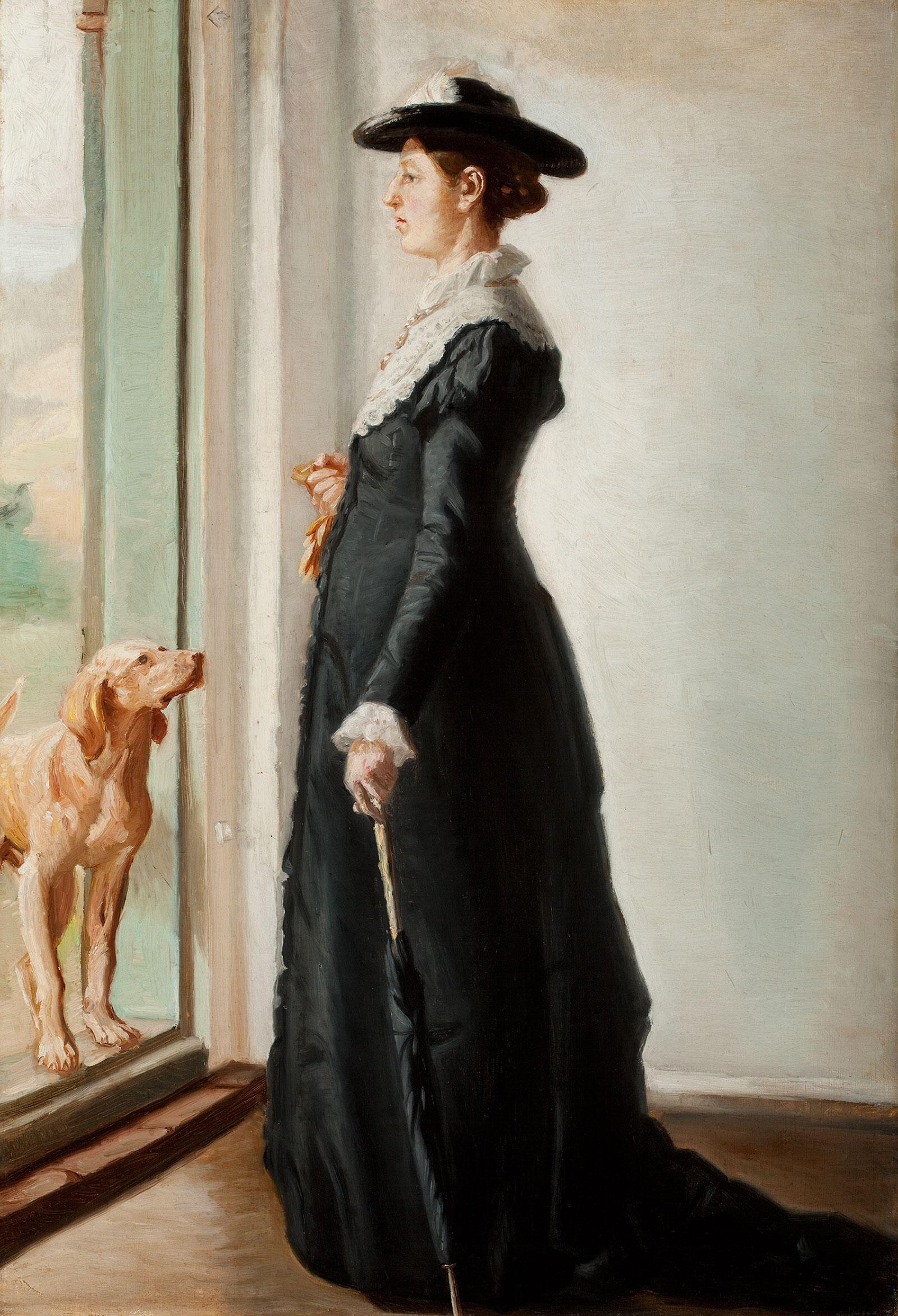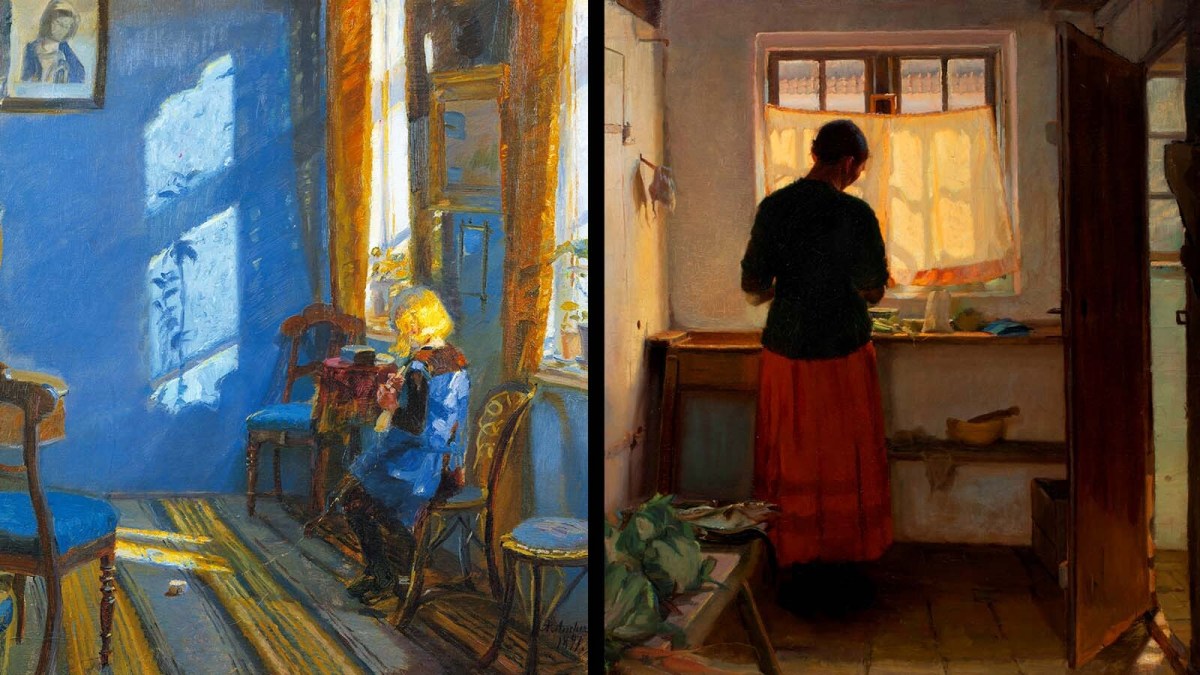Skagen, a remote fishing port at the northernmost tip of Denmark, where the clashing waters of the Skagerrak and Kattegat seas meet, is immediately appealing. When I visit in mid-October, the sun is shining and the autumn leaves are crinkled and crisp, yellow and red like the distinctive coloured houses. Today almost half of them belong to wealthy folk from Copenhagen who enjoy spending the summer by the coast, but in the late 19th century the demographic looked rather different. There were fishermen, yes, plenty of fishermen — and a thriving community of international artists who left bustling cities behind in search of a simple way of life.
I’m here for one artist in particular, Anna Ancher (née Brondum), who was 12 years old when the first painters of what would become the Skagen art colony pitched up in 1872. If the name doesn’t ring a bell, don’t worry, you’re not alone. One of Denmark’s greatest artists remains relatively unknown to British audiences, although a big exhibition opening next month at Dulwich Picture Gallery in London is sure to remedy that.
In Skagen, her art is everywhere: in Brondums Hotel where I’m staying (and where she was born in 1859); in the Skagens Museum across the street (a street called Anchersvej, or Ancher’s Road); and in the house round the corner where she and her husband lived and worked until her death in 1935 (at which point their only daughter bequeathed it to a foundation to preserve; Anchers Hus opened as a museum in 1967).

Ancher’s house in the Danish town of Skagen
ALAMY
Her art is everywhere in Skagen, and Skagen is everywhere in her art. Throughout her life, Ancher repeatedly painted the family hotel, her married home, and the local environment with its rugged scenery, working people, traditions and religion. With expressive, sketchy brushstrokes, she created radiant interior scenes and intimate portraits — a girl sewing, her mother huddled beneath a bulky blanket, a fisherman whittling sticks — that paid as much attention to light, and the atmosphere it conjured up, as the models. The way evening light tiptoes over the surface of a wall. The effect morning rays have on a weatherbeaten face or hardworking hands. In her landscapes, light glints across gardens, fields, the beach and the moors.
• The best exhibitions in London and the UK to book now
It was partly the light that brought progressive artists to this traditional fishing village; sandwiched between two seas, with lashings of salt spray, the area was thought to be uniquely bright. The dramatic landscape was perfect for plein air painting — on the rise since the introduction of portable tin paint tubes in 1841 — and the secluded, rural setting was pleasingly wild. Before they found permanent lodgings, the only place they could stay was Brondums Hotel, which was owned by Ancher’s parents. Eager to learn how to draw and paint, young Anna had unofficial teachers on tap. A decade later, the hotel’s dining room was decorated with a frieze of portraits of the colony’s members, now in the museum, a who’s who of the Skagen set, modern and bohemian.

Brondums Hotel dining room, Skagen, 1891
COURTESY SKAGENS MUSEUM

Anna and Michael Ancher at home
At the centre are Anna and her husband, Michael Ancher, a Danish painter who travelled from Copenhagen to Skagen in search of inspiration in 1874. Like the others, he was tired of the romanticised attitude of the previous generation and seeking subjects that were rough and real. They met that year, and he encouraged her to pursue a career as an artist. “Now be diligent about drawing and let it be your goal to become a painter, and everything will most likely go well,” he wrote to her in January 1875.
He wasn’t alone. Despite being deeply religious, her mother, Ane Brondum, wanted more for her children than marriage and in 1875 supported her 15-year-old daughter’s decision to enrol in Vilhelm Kyhn’s private school for gifted female painters in Copenhagen (the Royal Danish Art Academy didn’t accept women until 1888).
Not everyone was so enthusiastic. After she and Michael married in 1880, and she had given birth to her daughter, Helga, three years later, Kyhn advised her to toss her pochade painting box into the sea. But with the support of her family she continued painting against the odds, and successfully exhibited year on year. In the house the young family shared from 1884, I linger in front of Anna Ancher standing in the Doorway. Study for ‘Portrait of my Wife’ (1883), a provocative portrait by Michael that shows Anna on the brink of motherhood, standing before an open door (and a sniffing dog). It’s hard to know whether or not she worried that the birth of a child would derail her career, but this bold painting of the artist, visibly pregnant, about to step outside, shows a composed and confident woman who refuses to be kept at home.

Anna Ancher standing in the Doorway. Study for ‘Portrait of my Wife’ (1883) by Michael Peter Ancher
ALAMY
Together, the Anchers travelled through Europe, with stints in Germany, the Netherlands, Italy and Britain. Along the way, they immersed themselves in the old masters, and collected books and objects that to this day dot the tables and shelves of Anchers Hus, perfectly preserved along with artworks by friends and colleagues. In her quiet scenes of solitary women in domestic spaces are glimpses of the Dutch 17th-century art she admired in Vienna. In The Maid in the Kitchen (1883-6), a maid in a poppy-red skirt faces away from us and towards a window partially covered with a café curtain that’s creamy yellow with daylight. The wall is bare, the stone floor cold and hard. Fresh fish, soiled carrots and a couple of cabbages await preparation on a wooden bench in the foreground.
• The best art, music and cultural events this week — the critics’ guide
In 1889 they settled in Paris for six months, where she continued her training with other female artists and saw paintings by Claude Monet, Camille Pissarro and Paul Cézanne. She may not have taken up the subjects of urban life so beloved by the impressionists and post-impressionists — the smoky cafés and stage-like streets — but she was influenced by their preoccupation with visual experience. She, too, wanted to capture a mood, the play of light, a fleeting moment in time — and, upon her return to Skagen, her compositions became more ambitious, her palette more vibrant.
My favourite among her paintings, Sunlight in the Blue Room (1891), has already been shipped to London for the exhibition by the time I arrive in Skagen: it shows her daughter, Helga, knitting in the blue room at Brondums Hotel. She’s wearing a matching blue dress and perched on a chair whose seat pad is blue too. With her back to us, she’s working her needles; a stringy piece of wool unspools from a ball on the striped carpet. In the top left-hand corner is a hazy image of the Virgin Mary, her forehead dipped towards the little girl. There are two more chairs — empty, our invitation to enter the scene — and a small table. Sunlight filters through the window and lands on the wall in three expressive, thickly painted swatches, interrupted by the wiry shadow of a potted plant. The brightest point in the painting is Helga’s golden-yellow hair, illuminated by a sunbeam.

Old Man Whittling Sticks, 1880 by Anna Ancher
COURTESY SKAGENS MUSEUM
It’s the room I’m most looking forward to seeing at the hotel, and although the blue walls are paler and more muted now, I’m delighted to see similar sunspots skipping across the surface. Back then, it was a small semi-private dining room; today it’s booked out for meetings and private dining by businesses from across the country, as well as those wealthy residents who come and go with the good weather.
Before I leave Skagen, I walk to the beach at Grenen, the tip where the two seas blend and break. To my left are grassy dunes, flickering in the wind. To my right, seals loll about on a large rock, sunbathing. Back in the direction from which I came is a long row of almost-identical yellow houses with red-tiled roofs; today, the ones with sea views unobstructed by the huge harbour, built between 1904 and 1907, go for millions. In my mind, it’s a bit like Long Island, with its monied summer guests, and St Ives, another coastal centre for modern art. But by the time I reach the narrowest sliver of land, lapped by water, I can see that it’s also its own thing, distinct and bright.
As is its most famous former resident, who riffed on the paintings of the past while incorporating the colour and light effects of the Parisian avant-garde. Who was part of the Skagen set, but also apart from it, the only member native to the town, with a personal connection to her sitters and daily life. Who was denied the formative training her male peers received at the Academy, and forged her own path.
• Read more art reviews, guides and interviews
In 1913 the Anchers added an extension to their house, designed by the Danish architect Ulrik Plesner, a friend of the Skagen painters, and Anna finally got her own studio. A studio well-lit with two windows facing north and east, and a skylight for good measure.
Anna Ancher: Painting Light is at Dulwich Picture Gallery, London, Nov 4-Mar 8, 2026

